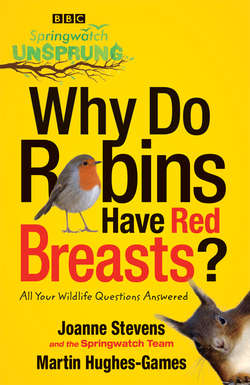Читать книгу Springwatch Unsprung: Why Do Robins Have Red Breasts? - Jo Stevens - Страница 22
Follow Your Nose
ОглавлениеIs it true that if released within a mile of your house, a mouse can navigate back? If so, how? Is it celestial navigation? Kirsty from Lisburn, Northern Ireland
Many animals have a strong homing instinct, used either during migration or simply to return home at night after a hard day’s foraging. It makes sense that an animal must have a mental map to find its way around its home range or territory. House mice have variable home-range sizes depending on where they live and how much food is available. In a chicken barn with plenty of grain they may live in a tiny area of just four square metres; however, where house mice live out in the wild away from humans their home range may cover as much as one or two square kilometres. Most mice in homes will stay within an area less than 10 metres in diameter.
House mice are nocturnal and don’t have colour vision. Their other senses more than compensate for their bad sight. Mice have good hearing and can detect ultrasonic sounds. They use their sensitive whiskers to find their way around in the dark. House mice exhibit ‘thigmotaxis’ which is a tendency to follow solid surfaces; for example, they prefer to run around the edge of a room, staying close to the wall, rather than run across open spaces. They use regular paths and runways to move around their patch, whether that’s in a house or field. Mice also leave urine scent trails and spray landmarks around their territory. They are curious and constantly explore their home range using taste, smell and touch to memorise obstacles and where to find food and water.
As long as food is available, house mice have little cause to leave home, except when they are young and disperse to find their own territory. Some house mice have been recorded travelling up to 2.4 kilometres, but they usually don’t roam that far.
So what happens if an animal is taken out of its local area and plonked in a strange new location, such as when a mouse is live-trapped and released well away from home? It seems that mice use various senses to navigate. Blind mice are worse at homing than sighted mice so vision must play a role. Mice are much better at homing if they are less than 135 metres from their original position. House mice don’t tend to range very far so they may not need to be good at homing over large distances, but other species of mice that habitually travel across big areas of landscape are very adept at homing.
Experiments with deer mice (Peromyscus maniculatus) in North America showed that they could find their way home even if they were moved by up to two kilometres. How they navigate is uncertain. Some studies have suggested that certain species of mice might be able to detect the Earth’s magnetic field with an internal compass, similar to migrating birds, while other researchers have found that voles may use the sun to navigate. Other biologists believe that mice may just wander extensively if lost and eventually find their way home by luck rather than judgement. Despite the conflicting evidence, homeowners are still advised to release any mice that they trap well away from their house (or any other houses for that matter!); some pest controllers recommend relocating the mice up to a distance of 3.2 kilometres. The best bet is to try to prevent house mice entering your home by sealing up any access points, especially where food is kept. Bird food kept in a shed or garage can attract rodents so it is wise to keep any nuts, seeds, etc. in sealed tubs or bins that are tough enough to withstand sharp little teeth.
